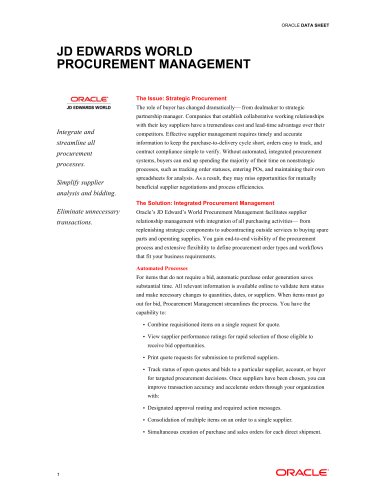
Catalog excerpts
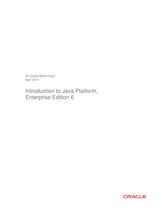
An Oracle White Paper April 2010 Introduction to Java Platform, Enterprise Edition 6
Open the catalog to page 1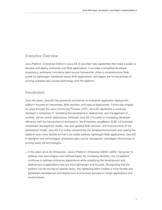
Oracle Wtirki »*aprrr Irrtrrxuchon ta Java WatTonn. hntrfpnw l-drti<xi 6 Executive Overview Java Platform, Enterprise Edition 6 (Java EE 6) provides new capabilities that make it easier to develop and deploy enterprise and Web applications. It provides a simplrfied developer exprience; embraces innovative open source frameworks; offers a comprehensive Web profile for lightweight. standards-based Web applications; and begins the formai process of pruning outdated and unused technology from the platform. Introduction Over the years, Java EE has gracefully evolved as an enterprise application...
Open the catalog to page 3
Oracle Wnre »*aper Irrirrxiufhon ta Jjrvn PWTonn. hntrfpnw t-drti<xi 6 > Profiles contribute to the flexibility of Java EE 6. The idea is to dcoupl響 spcifications to enable combinations suited for diffrent use cases. For example, the Web Profile brings togetherjust the technology needed for Web applications. Additional profiles being consklered would be created via the JCP. 驕 Similarto deprecation, pruning removes outdated orunused technologies such as EJB Entrty Beans, Java API for XML Registries (JAXR), and others. Pruning provides an orderly way to alert organizations that a technology...
Open the catalog to page 4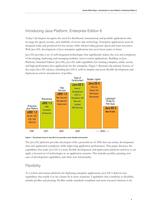
Oracle Wnre IMptrr Irrirfxiuchon to Jjrvn PWTonn. hntrfpnw f-ditioci 6 Introducinq Java Platform. Enterprise Edition 6 Today *s dcvclopcrs rccognizc the need for distributcd, transactional, and portable applications that leverage the speed, security, and teliabilty of sexvei-sidr technology* Enterprise applications rnust bc destgned. built, and pioduced fot les s moncy while still providlng gieatet speed and motc resoutees. With Java EE, development of Java enterprise applications has never been casier or fasecr. Java EE provides a set of wcll-integrated tcclmologics diat significandy...
Open the catalog to page 5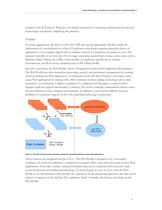
Oracle Wnrki IMptrr brtrnduchon to Jjrvn PWTonn. hntrfpnw f-dition 6 crcatcd via the JCP process. Pruning is an orderly mechanism for reducing outdated and Icss relevant lecluiologics and theiebv simpliiving the phuloini Profiles For m any applications, the full set of Java EE API s niay not be appropriatc. Profiles enable the deploymeni oL a ^landatdized set oljava lit platfoim technologies tafgClig p.HiUcuhi rJtftMfl ot applicationsfor example, aligued with an industry vertical or a frequcntly occurring use case. The concept of profiles is not new: Java EE leverages exp뗩rience gaincd from...
Open the catalog to page 6
Oracle WWK Paper mrrrxuchon ta Java PWTonn. hntrfpn*e F-ditioci 6 TABLE 1. JAVA tt 6 WtBPKOM h Afin JAVA FF fi FI11 I Pi AlfORM JAVA t-t- G WtH PROF LE JAVA F.F.6 (UN P1AIH)RM Scrriel3 0 Scrvtet 3.0 JavaServer Pages (JSP) 2 2 JavaServer Pages (JSP) 2 2 expression Language (EL) 2.2 Expression language (EL) 2 2 Dcbugﯧpng Support tor Other Languages (JSR 045) lctxjgging uppcl lor Other l anguages (JSR M5) Standard Tag l ibrary for JavaServer Pages (JSTI ) 1 ? Standard Tag 1 iorary Tor JavaServer Pages (JSTI ) 1 7 JavaServer Faces (JSF) 2.0 JavaScrvcr faces (JSF) 2.0 Common Annotations tor Java...
Open the catalog to page 7
Oracle Wire »*aper Inttixuchon ta Jjrvn PWTonn. hntrfpn*e t-drti<xi 6 Pruning Pruning a spﯩcification means that il can become an optional (racher dian a requircd) component in llie next rcleasc of the platform. By carcfully pmning APIs that are ontdatcd, not well supportcd, or not widely deployed, Java EE can achieve a more lightweight platform diat's casier to use and provides zoom for euhancements and refinements. Pruning is marked in the JavaDoe, indicating that a spcification is a candidate for becoming optional. More spccifically, dus means diat die identified technologies may bc...
Open the catalog to page 8
OTKle Wwfc Paper mrrrxuchon to Java PWTonn. hntrfpnw f-ditioci 6 Servlet 3.0 The Servlet 3.0 spcification is a major foc us of Java EE 6- In Java EE 5, servlet classes and ihe accompanying web.xml file (whirh includcs configuration metadata) werc nccdecL In Servlet 3.0, annotations aie used to dclare servlet s驗which mcans that web.xml files axe no longer icquired. Serviet 3.0 makes it casier to add thiid-paxty libraries without any web.xml changes. (Note that web.xnil isoptional and can still be used wherc dsirable.) For example, JavaScrvcr Faces (JSF; 2.0 is integrated Lnto Oracle...
Open the catalog to page 9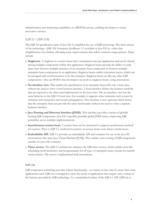
Oracle Wtirki l'arer Irrirfwiuchon ta Jjrvn PWTonn. hntrtpnw f-ditioci 6 administration and monitoring eapabilities as a RESTful service, cnabling dcvclopcrs to create iimovativc services. EJB3.1 (JSR318) The EJB 3*0 spcification {part of Java EE 5) simplificd the use of EJB technology. The latest release of the technology穗JSR 318: Enterprise JavaBeans 3.1 (availablc in java EE 6)takes that simplification even further, affording many improvements diat reflect common usage patttrns. Thרse include Singletons. A singlcton is a session bean that* s instantiatcd once per application and can bc...
Open the catalog to page 10
Oracle Wirta l'arer IrrtrrKuchon ta Jjrvn PWTonn. hntrtpnw f-ditioci 6 ncithcr a one-off product not an implemcntation. Applications dcvclopcd vrithEJB Lite can run in application serve» tliat implement cither the Web Profile or the fui) Java EE 6 platform* Dcvclopcrs can lise HJB litc to simplify the development of secure, transactional business components without baving to master the tull power of EJB up front. Vendor implcmcntations of EJB Lite are expected to be simplcr and more focused than iull EJB component implcmentations. EJB Lite is also pan of the Web Profile. Sec Table 2for a...
Open the catalog to page 11
Oracle Wtirki l'arer IrrtrrKuchon ta Jjrvn PWTonn. hntrtpnw f-ditioci 6 篕 Criteria API. Based on the metamodel concept, this type-safe query mechanism can verify persistent Java objects. It can bc statcally ot dynamically accessed. A stxiiig based model is also availablc, but it*s not as type-safe. Contexts and Dependency Injection (CDI) for Java EE (JSR 299) Dcpcndcncy injection can be applied to ail die resources a component needs, cffectivcly hiding die cration and lookup of resources from application code. It cnablcs the Java EE container to automatically insert r響frences to other...
Open the catalog to page 12All Oracle catalogs and technical brochures
-
Oracle Analytics
4 Pages
-
STORAGETEK SL150
5 Pages
-
Oracle Server X7-8
6 Pages
-
Oracle Server X7-2
6 Pages
-
Oracle’s SPARC T7 and M7
6 Pages
-
Oracle Solaris 11
3 Pages
-
sparc-t5-2-ds-1922871
6 Pages
-
ds-timesten-imdb-129255
3 Pages
-
osb
2 Pages
-
oracle-database-editions-wp-12c
19 Pages
-
MySQL
4 Pages
-
ORACLE SOLARIS 10
5 Pages
-
Oracle Linux (White Paper)
23 Pages
-
ORACLE SOLARIS 11.1
4 Pages
-
Oracle Fusion Middleware
556 Pages
-
pillar-axiom-600
6 Pages
-
036083
4 Pages
-
DB
2 Pages
-
erp-cloud
7 Pages
-
netra-blade-x3-2b
4 Pages
-
etra-sparc-t4-2-ds
4 Pages
-
netra-server-x3-2-ds
5 Pages
-
m-seriesarchitecture
64 Pages
-
sparc-t4-4
4 Pages
-
dynamic-tracing
2 Pages
-
solaris-zfs
3 Pages
-
solaris-10
5 Pages
-
Oracle WebCenter
8 Pages
-
Sun Server X2-8
5 Pages
-
Sun Server X2-4
5 Pages
-
Sun Server X3-2L
5 Pages
-
Sun Server X3-2
5 Pages
-
sun-fire-x2270-
4 Pages
-
servers-storage
19 Pages
-
sparc-supercluster
6 Pages
-
public-sparc-roadmap
4 Pages
-
hardware-brochure
8 Pages
-
berkeley-db-xml
2 Pages
-
berkeley-db
2 Pages
-
berkeley-db
2 Pages
-
exadata
2 Pages
-
database-firewall
2 Pages
-
advanced-security
2 Pages
-
big-data
16 Pages
-
034782
5 Pages
-
java-tech-for-embedded
2 Pages
-
em12c-executive
2 Pages
-
dms-11g
4 Pages
-
oracle_DATA.pdf
22 Pages
Archived catalogs
-
Sun Network 10GbE Switch 72p
4 Pages
-
Sun Storage 2500-M2 Array
3 Pages
-
Sun Blade 6000
5 Pages
-
Sun Blade X6270 M2
4 Pages
-
Oracle Learning Management
5 Pages
-
Oracle Human Resources
5 Pages




































































